South Face of Pillar I, Horus Iunmutef
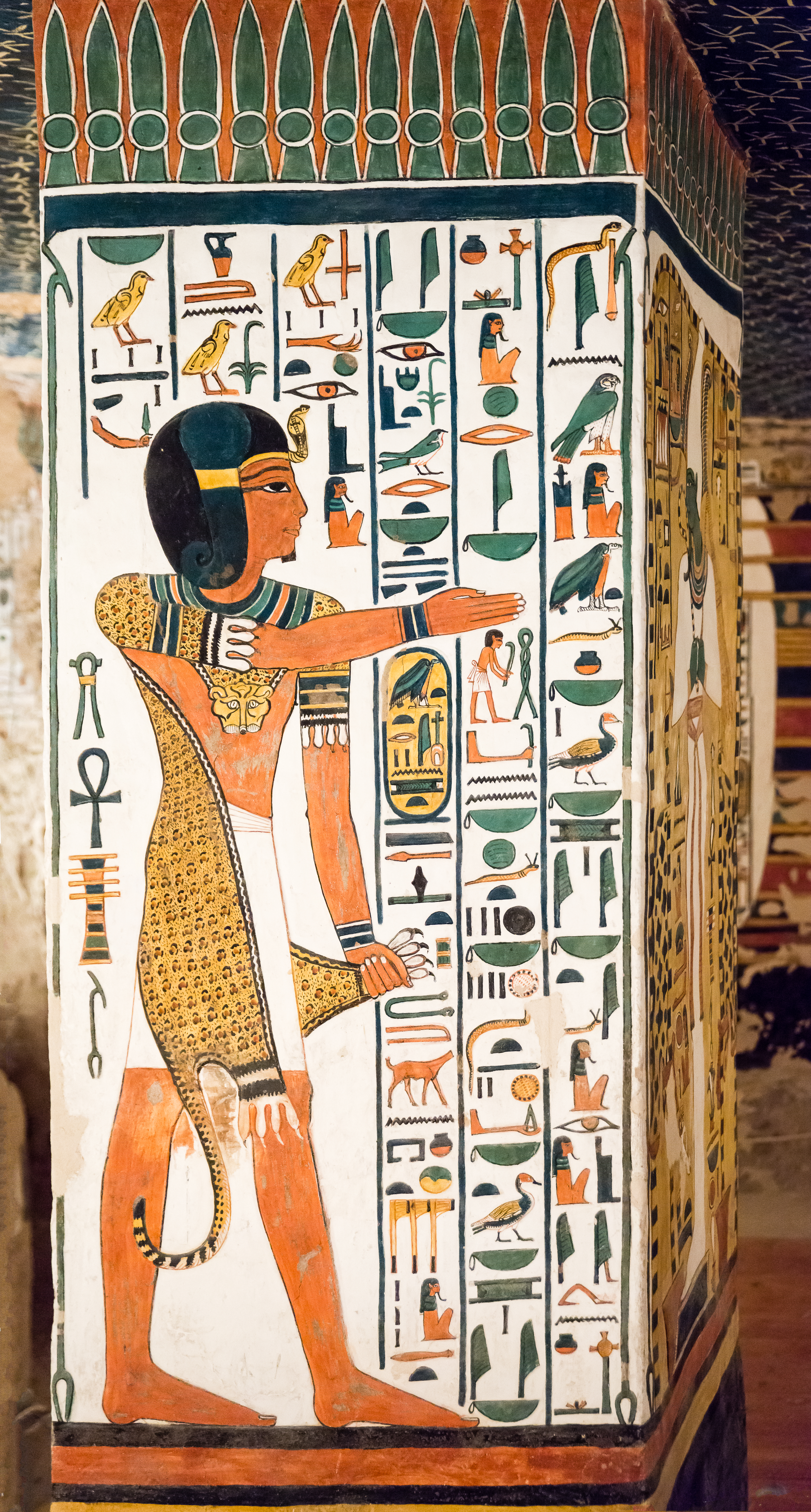 |
| Photo by kairoinfo4u (Flickr), permission granted for educational use. |
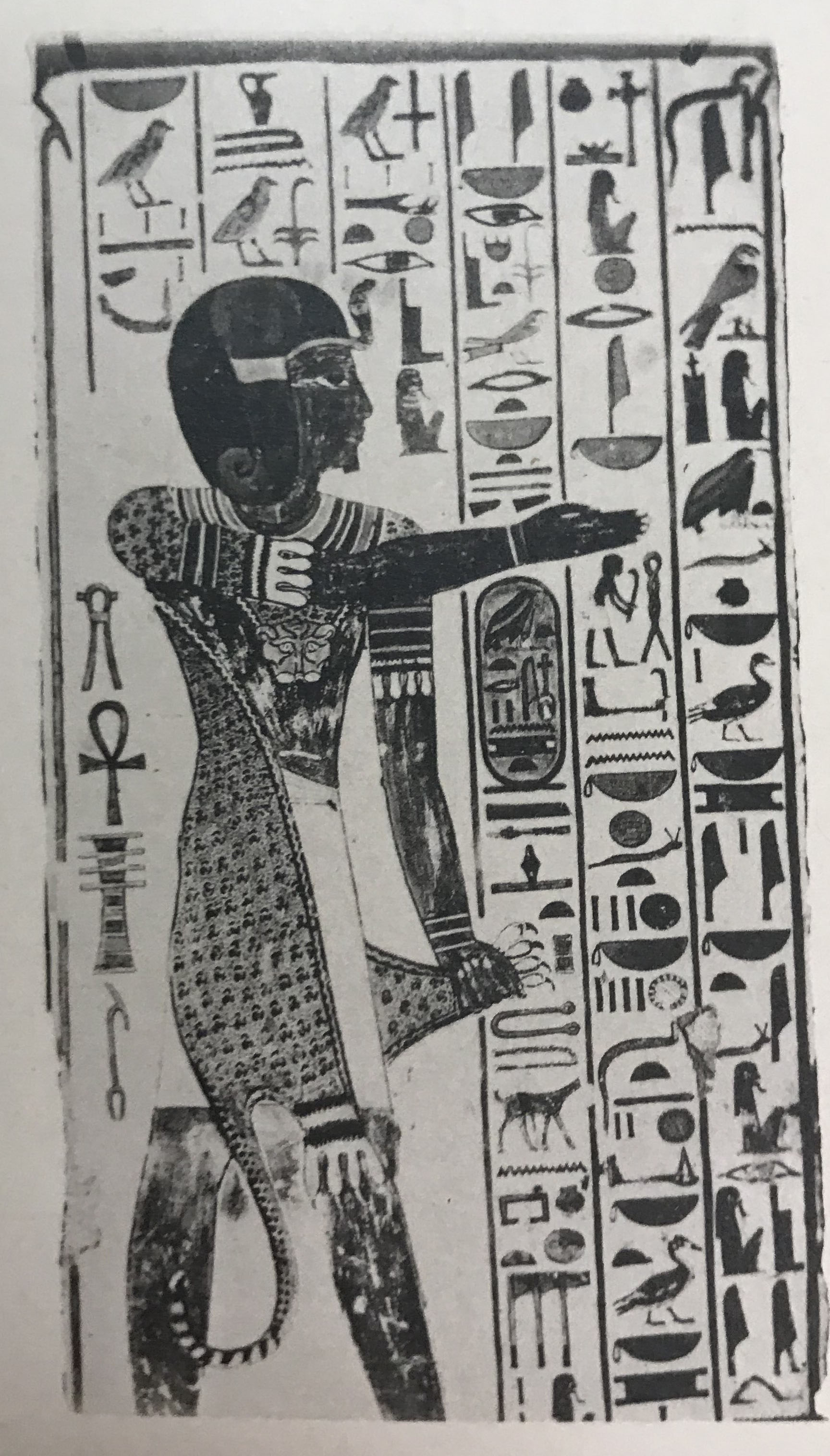 |
| Photo: Ernesto Schiaparelli (1904), “La Tomba di Nofretari Mirinmut,” Relazione sui lavori della missione archeologica italiana in Egitto, Volume 1 (Torino, G. Chiantore, 1923), 95. |
|
1. Dd mdw in Hr Iwn-mw.t=f ink sa=k mry=k it=i Wsir ii.n(=i)
1-2. nDnD=i xri=k
Words spoken by Horus Iunmutef: “I am your son, whom you love, my father Osiris, I have come to you, in order to take counsel with you.
2. Hw.n(=i) n=k xfty.w=k (sp-4) D.t. di=k sa.t=k mry=k
I have smitten your enemies for you (4x) for eternity. May you cause that your daughter, your beloved one,
3. {y=k} Wsir Hm.t nsw.t wr.t nb.t tA.wy (Nfr.t iry mr(.y)t n Mw.t)| mAa(.t) xrw Htp=T m iwnw PsD.t aA.t
The Osiris, Great wife of the king, Lady of the Two Lands Nefertari Meritenmut, true of voice, rest in the sanctuary of the great Ennead,
4. imy.w xt Wsir
who follow (temporally) Osiris,
5-6. Xnm.n sw nb.w tA Dsr
whom the lords of the Sacred land have joined.”
sA anx Dd wAs
Protection, Life, Stability, and Dominion
|
|
West Face of Pillar I, Hathor with Nefertari
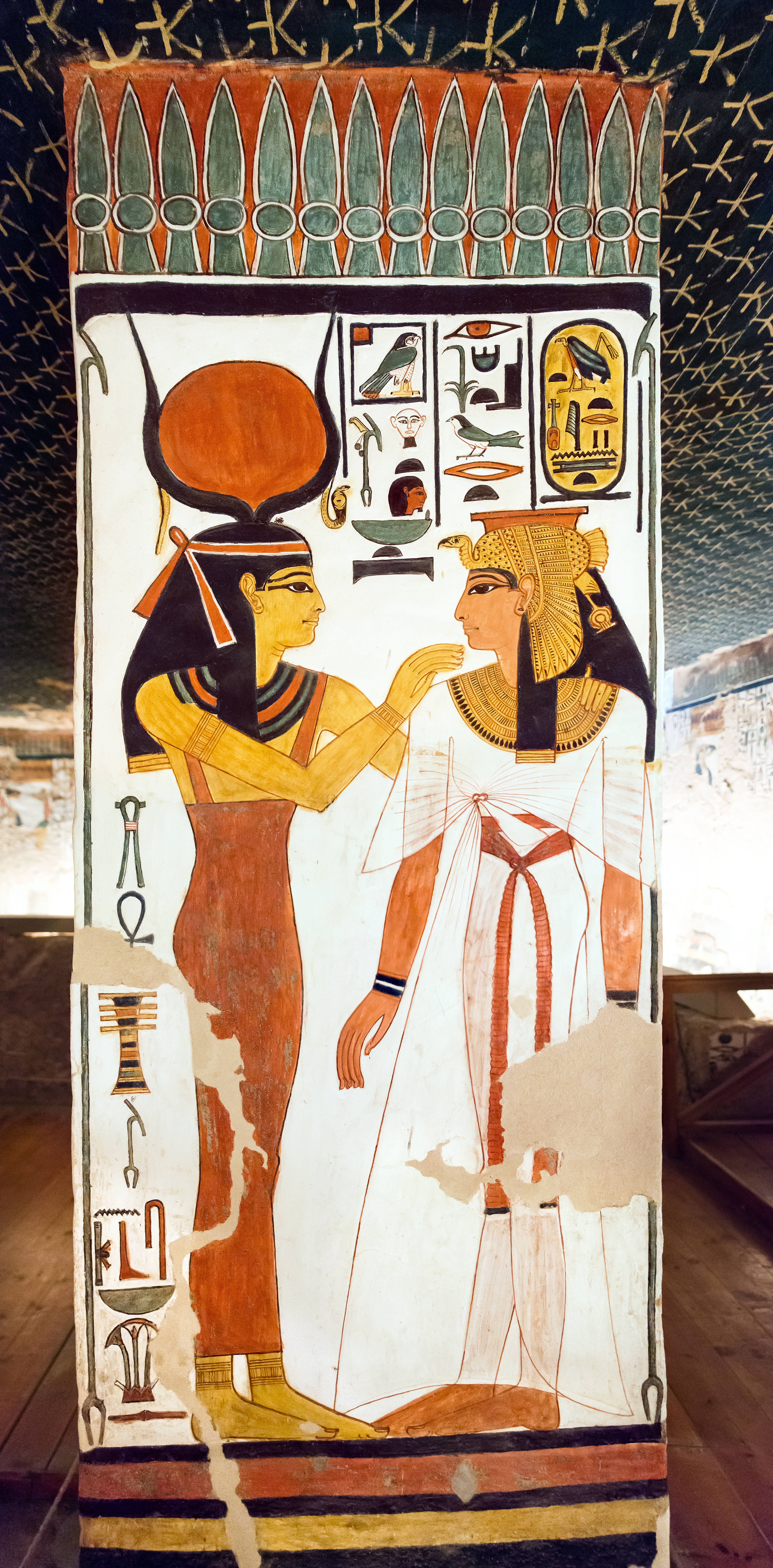 |
| Photo by kairoinfo4u (Flickr), permission granted for educational use. |
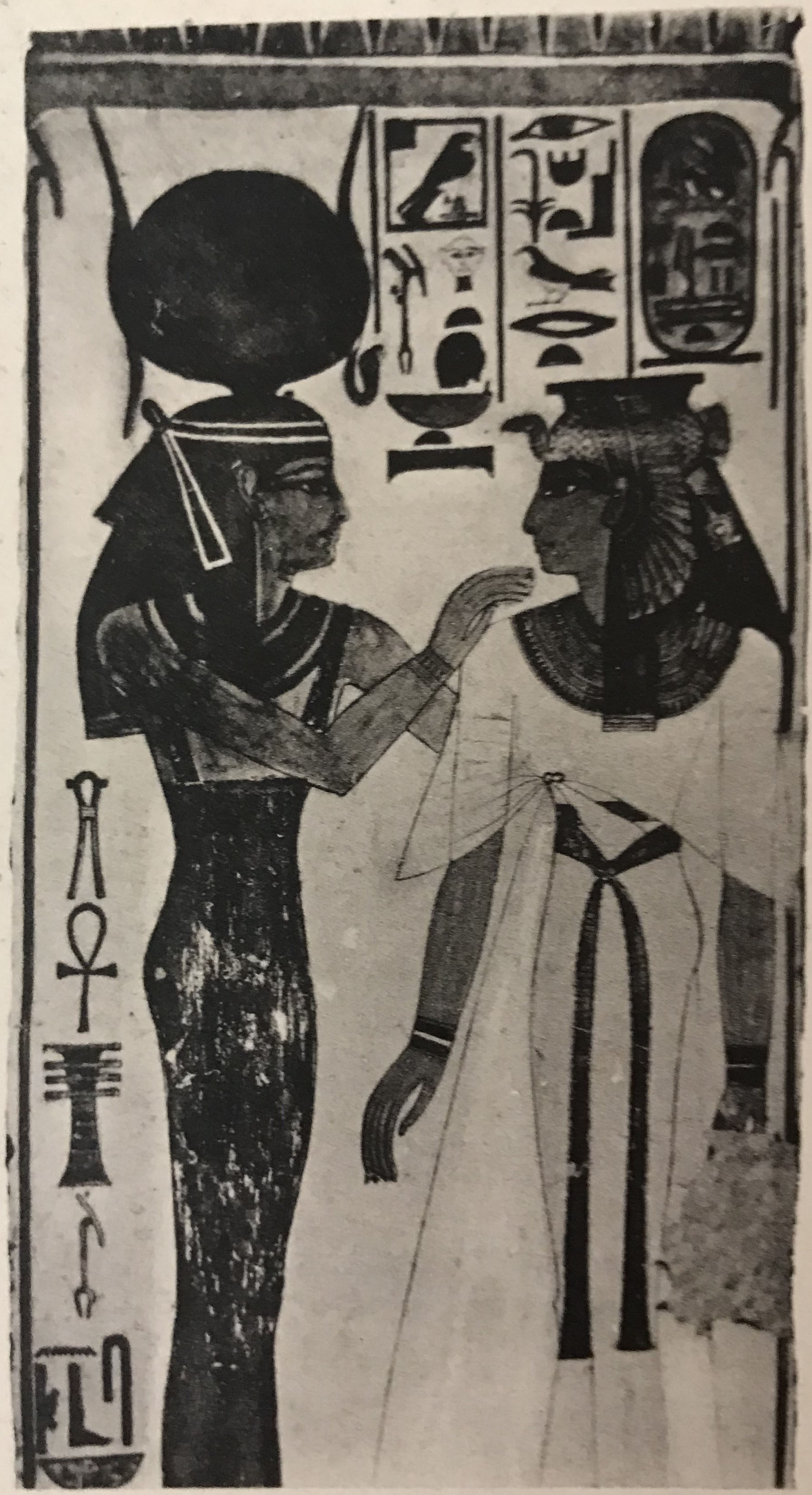 |
| Photo: Ernesto Schiaparelli (1904), “La Tomba di Nofretari Mirinmut,” Relazione sui lavori della missione archeologica italiana in Egitto, Volume 1 (Torino, G. Chiantore, 1923), 95. |
|
Hw.t-Hr hr.t-tp wAs.t nb.t p.t
Hathor, Chieftainess of Thebes, Lady of the sky
Wsir Hm.t nsw.t wr.t (Nfr.t-iry mr(y).t n Mw.t)|
The Osiris, Great Wife of the King, Nefertari Meritenmut (Beloved of the Goddess Mut).
sA anx Dd wAs snb nb HA=s
All Protection, Life, Stability, Dominion,and Health are behind her.
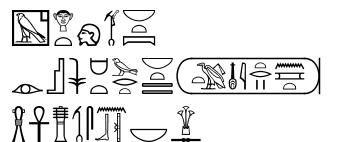
|
|
East Face of Pillar I, Osiris
 |
| Osiris from the East face of Pillar I, Photo: Ernesto Schiaparelli (1904), “La Tomba di Nofretari Mirinmut,” Relazione sui lavori della missione archeologica italiana in Egitto, Volume 1 (Torino, G. Chiantore, 1923), 95. |
|
On the inner side of the Pillars facing the stairs (I east, II west, III east, IV west) are images of Osiris.
Depicted as a mummy, wearing the atef-crown, Osiris stands in a golden shrine, holding a crook and flail.
On either side of him are two stuffed, headless leopard skins tied on poles, planted in stands resembling flowerpots.
These are imuit fetishes, usually associated with the god Anubis.
1-3. Wsir xnty imnt.t nTr aA HqA psD.t
Osiris, foremost of the west, the great god, ruler of the Ennead.
In front of his body: di.n(=i) n=T xaa Ra m p.t
I have given to you (f.) the appearance of Re in Heaven.
Behind his body: sA anx Dd wAs HA=s nb mi Ra
All Protection, Life, Stability, Dominion are behind her, like Re.
|
|
South Face of Pillar I: Djed-Pillar
 |
| Detail of photo courtesy of kairoinfo4u (Flickr), permission granted for educational use. |
 |
| Photo: Ernesto Schiaparelli (1904), “La Tomba di Nofretari Mirinmut,” Relazione sui lavori della missione archeologica italiana in Egitto, Volume 1 (Torino, G. Chiantore, 1923), 95. |
|
On the inner south and north faces of these pillars (I north, II north, III south, IV south) are Djed-Pillars, they face toward the lower part of the chamber, which contained the sarcophagus.
There is slight veriation in the text for each Djed-Pillar
Top (right to left): Wsir Hm.t nsw.t wr.t (Nfr.t iry mr(.y)t n Mw.t)| mAa(.t) xrw
The Osiris, Great wife of the king, Lady of the Two Lands Nefertari Meritenmut, true of voice
Right Side: Wsir Hm.t nsw.t wr.t nb.t tA.wy Hnw.t SmAw-mHw(Nfr.t iry mr(.y)t n Mw.t)| mAa(.t) xrw xr Wsir
The Osiris, Great wife of the king, Lady of the Two Lands, Mistress of Upper and Lower Egypt Nefertari Meritenmut, true of voice, in the presence of Osiris
Left Side: Hm.t nsw.t wr.t nb.t tA.wy Hnw.t SmAw-mHw (Nfr.t iry mr(.y)t n Mw.t)| mAa(.t) xrw xr Wsir
Great wife of the king, Lady of the Two Lands, Mistress of Upper and Lower Egypt Nefertari Meritenmut, true of voice, in the presence of Osiris.
|
|
|

